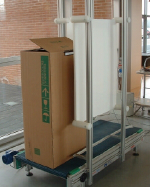May 16, 2003 – Lab ID, an RFID systems integrator based in Bologna, Italy, has unveiled a new tunnel reader designed to read large quantities of transponders contained in cartons moving along a conveyer belt. The company says its PowerTunnel can read up to 800 tags in close proximity.
“We had a request from a garment company that wanted to read from and write to many RFID tags at once,” says Marco Astorri, Lab ID’s executive VP. “The tags would be on a variety of items, including sun glasses, in boxes. They had to be read — without opening the box — to ensure that none of the items were missing.”
The solution Lab ID came up with consists of a conveyor made of a non-metallic material, so that one antenna can be mounted below the conveyor belt. Another antenna is mounted above the conveyor. You can vary the reader’s RF power output from 0.5 watts to 10 watts, so it can be used in North America, as well as in Europe.
The system comes with two antennas with a network composed of high power capacitors, inductors and an RF transformer. The antennas are typically placed above and below a conveyor, but they can also be mounted vertically on either side of a conveyor. A built-in multiplexer lets you connect up to eight antennas to the reader, so you can increase the read field.
Lab ID creates its own 13.56 MHz smart labels using I-Code SLI chips from Philips Semiconductors. The labels, which are compatible with ISO 15693, are 24 mm by 59 mm (about 1 inch by 2 inches).
The company demonstrated the capabilities of the system by placing 50 smart labels on 5 mm-thick cardboard sheets. The company placed 16 sheets with a total of 800 transponders inside of a carton box that was 640 mm long by 420 mm wide by 350 mm high (25 by 16 by 14 inches). A gap of about 15 mm was left between each sheet. Each transponder was placed directly above another transponder but had a margin of 5mm on all sides.
As the tags pass through the read field, all the tags not picked up by the first antenna are read by the second one. The company says that in its tests, the two readers picked up all 800 tags in the field. Software was used to unsure that the same tag wasn’t read twice. On average, the system read 24 transponders per second.
The systems may not read that many tags in real world conditions, where tags might not be perfectly oriented to the reader, or the contents of a carton get jumbled up and tags are in even closer proximity. But the company claims the PowerTunnel is an advance on current systems, which typically read no more than 150 transponders in close proximity.
“Reading a large number of tags in a close proximity is a big problem for most existing RFID systems,” says Astorri. “We’ve created a new type of antenna that creates an intense radiated field to enable the transponders to operate in a radiation field rather than a magnetic field common to other RFID systems. This allows the PowerTunnel to read a large number of transponders in a small space.”
Astorri says the tunnel reader is already being used by the Benetton Group, the Italian postal service, and two other companies that he could not name because of non-disclosure agreements. Pricing for the system has not been disclosed.
Don’t miss a groundbreaking RFID executive conference. Register today for RFID Journal Live!, Chicago, June 11 to 13, 2003.


